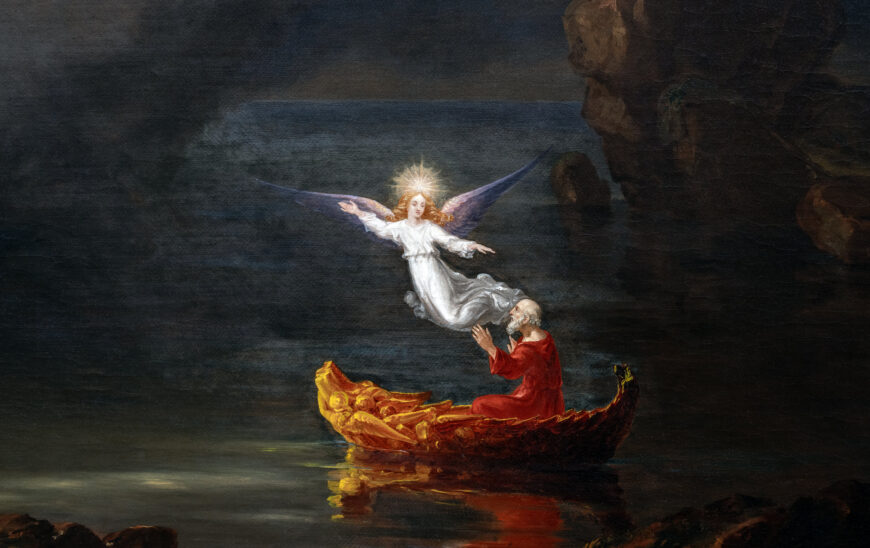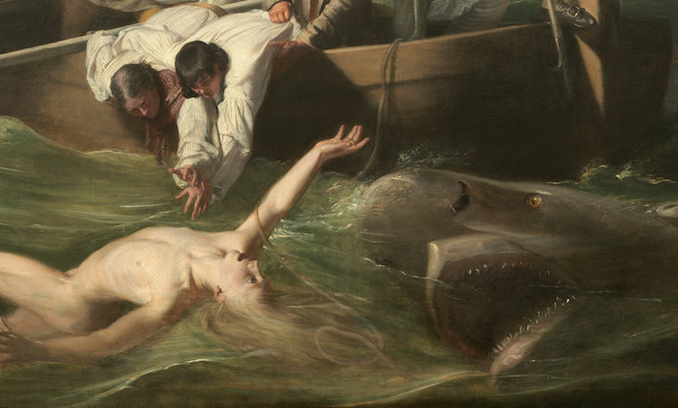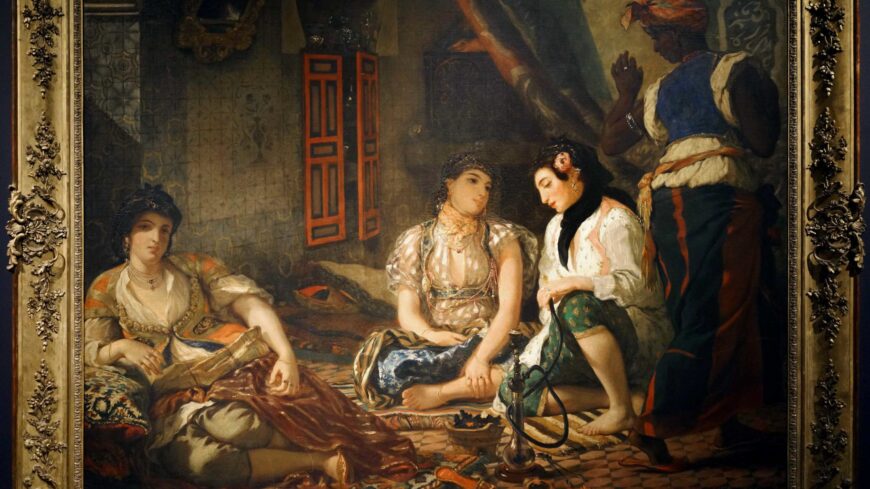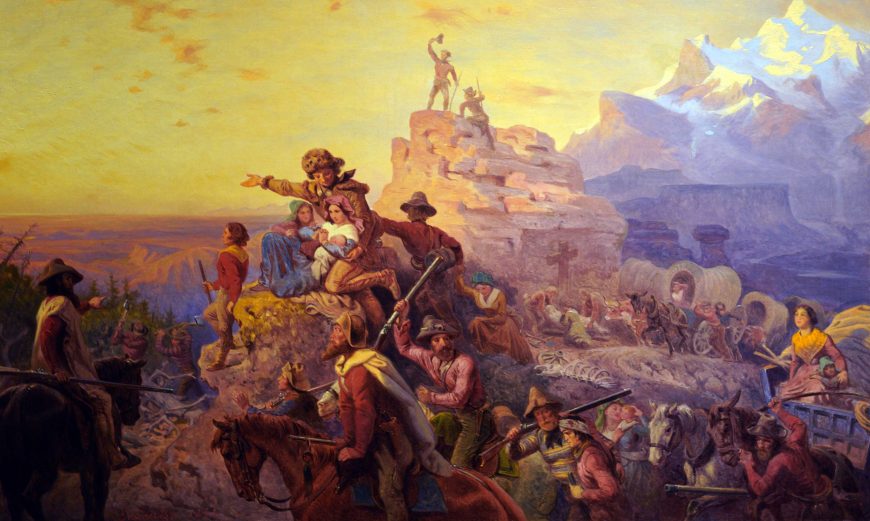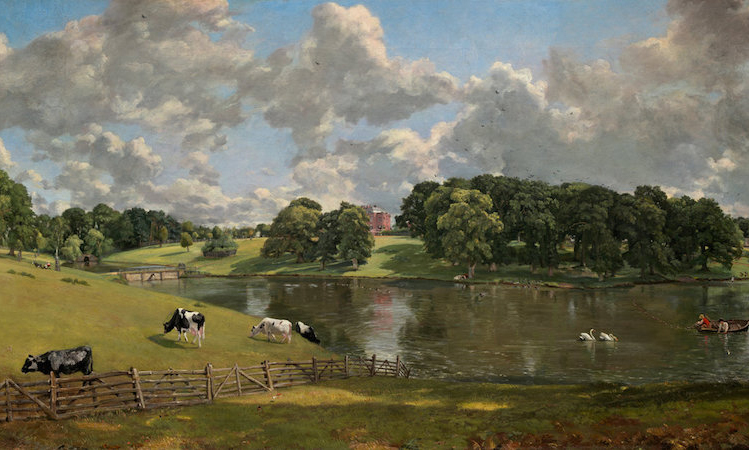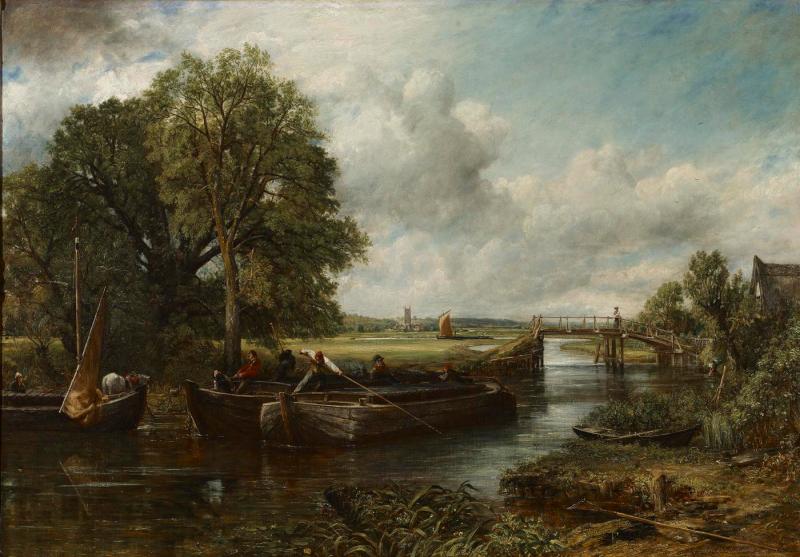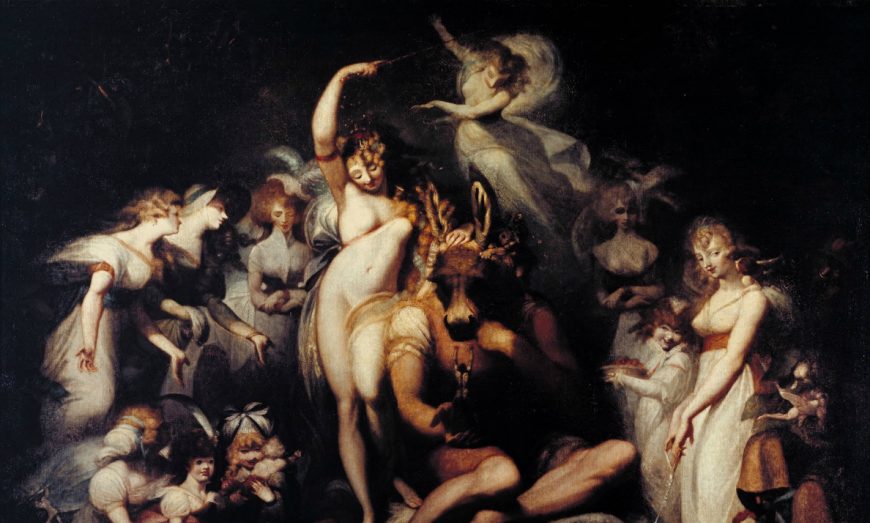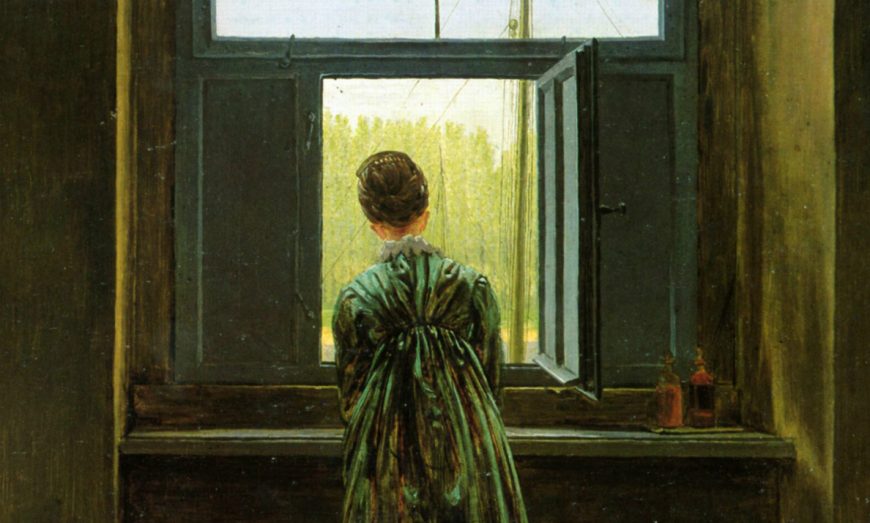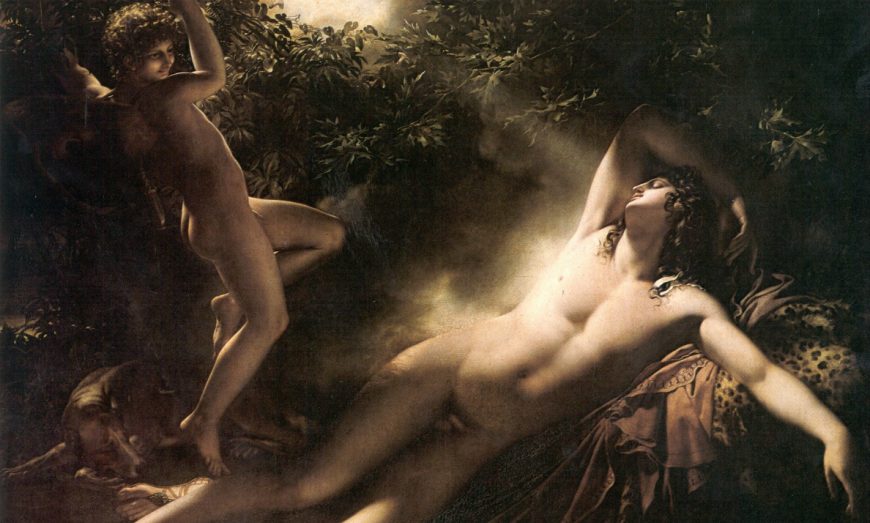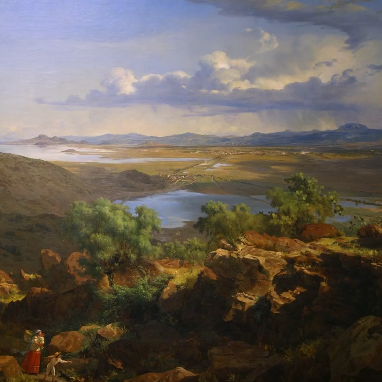Caspar David Friedrich, Monk by the Sea, 1808 or 1810, oil on canvas, 110 x 171.5 cm (Alte Nationalgalerie, Staatliche Museen zu Berlin)
[0:00] [music]
Dr. Steven Zucker: [0:04] In so much 19th-century painting, figures enact a narrative, a story, before us. We watch them as if we’re an audience looking into the space. But with the work of Caspar David Friedrich, so often he gives us a small lone figure. Instead of looking towards that figure, we in a sense become that figure. We begin to see what the figure sees.
Dr. Beth Harris: [0:26] That’s exactly what we have here in the “Monk by the Sea,” which is in so many ways a really radically modern pared-down image.
Dr. Zucker: [0:35] We have this vast sky, and it takes up the preponderance of the canvas. It looks cold and it’s clear at the top. These wisps of the clouds. Then it becomes much darker and much more menacing. The ocean below looks freezing cold. It’s almost black. We can just make out large swells of the waves.
[0:55] Then below that, the cold winter dunes, presumably near Greifswald in northern Germany. This is the Baltic coast. We see that monk below the sea’s horizon line.
Dr. Harris: [1:05] Because the figure that we’re looking at is a monk, we associate that figure with questions of the spiritual. We immediately turn our thoughts in that direction.
Dr. Zucker: [1:18] He is caught in those narrow bands of the earthly. He is below the horizon line, but he is aware. We then become aware of the vastness of the spiritual realm of the sky above, but also the threatening nature of the world in which we inhabit. Those whitecaps are just picking up the tops of what are really substantial waves.
[1:40] We can feel the power of nature, the power of that ocean. I think that notion of the sublime was a very important idea at the end of the 18th and in the 19th century. This is an ancient idea that was revived, probably most famously, by Edmund Burke in England. The idea was that there is a kind of beauty that is actually awe-inspiring through its power and its terror.
[2:05] That was a way of directly confronting God’s presence in our world.
Dr. Harris: [2:11] It’s both the vastness of nature and the smallness of man and the powerlessness of man. This figure seems to look toward the right. We know originally that Friedrich had painted a ship on the horizon, which certainly would have made this scene much more mundane.
Dr. Zucker: [2:30] The 19th century is the time most associated with man’s control over nature. This is a kind of antidote to that. This is saying no, nature is far greater than us. Our technological advances are allowing us to feel as if we have conquered nature. Here is a humble reminder that the opposite is really true.
Dr. Harris: [2:52] It’s right around this time that Mary Shelley is writing “Frankenstein,” where man has the ultimate power of creating life, like God. Doctor Frankenstein is punished for the pride that makes him think he can rival God.
[3:08] It’s really true that at this moment, at the beginnings of the Industrial Revolution, we have a sense of our own power, and at the same time, we question that power.
Dr. Zucker: [3:19] In the 19th century, one of the key questions is, “How can the grandeur and power of God, of spirituality, be represented in our more scientific, more industrialized culture?”
[3:33] The “Monk by the Sea” is meant to be seen with a pendant and is currently hung in the museum just to the left of the “Abbey in the Oak Wood.” It’s a wonderful pairing of paintings because they’re both deep winter.
[3:46] The monk that is so contemplative in the “Monk by the Sea” is thought to have been the figure that is being carried in the coffin in “Abbey in the Oak Wood.”
[3:42] [music]
Friedrich the modern
It seems strange now but for a while the art world turned its back on the German painter Caspar David Friedrich. Aside from being cursed with the label of Hitler’s favorite artist, for much of the twentieth century the Impressionists, with their loose, painterly style, were held to be the fathers of modern art. Friedrich’s work in comparison was considered too meticulous, too precise, too finely detailed to warrant serious critical attention.
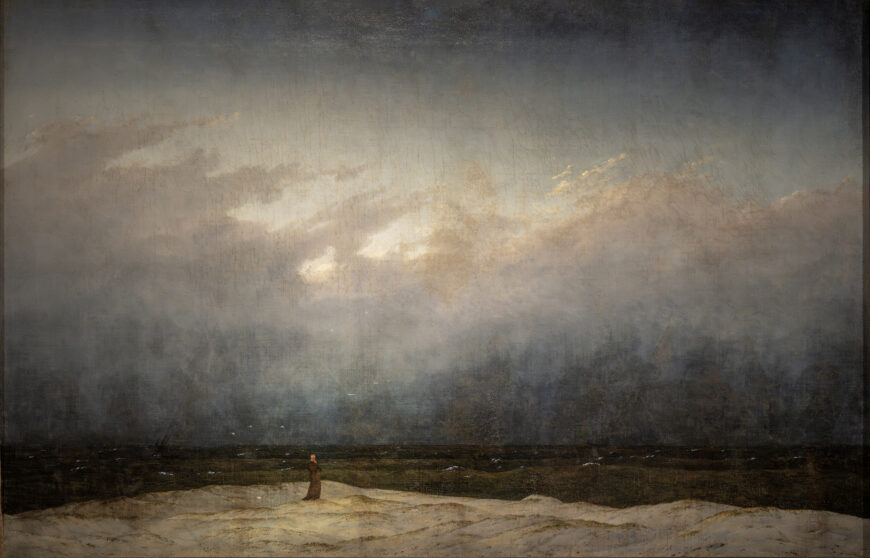
Caspar David Friedrich, Monk by the Sea, 1808–10, oil on canvas, 110 x 171.5 cm (Alte Nationalgalerie, Staatliche Museen zu Berlin)
Over the last few decades though the tide of opinion has turned. Now it is generally accepted that both in his technical brilliance and theoretically in his views of what the purpose of art should be, Friedrich was as radical as they come. But if proof were ever needed again of his credentials as one of the great forerunners of modern art, then The Monk by the Sea would have to be it.
A new departure

Friedrich, Abbey in the Oak Forest, 1809 or 1810, oil on canvas, 110.4 x 171 cm (Alte Nationalgalerie, Berlin)
Exhibited in the Academy in Berlin in 1810 along with its companion piece Abbey in the Oak Forest, it depicts a monk standing on the shore looking out to sea. The location has been identified as Rügen, an island off the north-east coast of Germany, a site he frequently painted.
The monk is positioned a little over a third of the way into the painting from the left, to a ratio of around 1:1.6. The same ratio can be found frequently in Western art and is known variously as the golden ration, rule or section. Aside from this nod to tradition however there is little else about this painting that can be described as conventional.
The horizon line is unusually low and stretches uninterrupted from one end of the canvas to the other. The dark blue sea is flecked with white suggesting the threat of a storm. Above it in that turbulent middle section blue-grey clouds gather giving way in the highest part to a clearer, calmer blue. The transition from one to the other is achieved subtly through a technique called scumbling in which one colour is applied in thin layers on top of another to create an ill-defined, hazy effect.
The composition could not be further from typical German landscape paintings of the time. These generally followed the principles of a style imported from England known as the picturesque which tended to employ well-established perspectival techniques designed to draw the viewer into the picture; devices such as trees situated in the foreground or rivers winding their course, snake- like, into the distance. Friedrich however deliberately shunned such tricks. Such willfully unconventional decisions in a painting of this size provoked consternation among contemporary viewers, as his friend Heinrich von Kleist famously wrote: “Since it has, in its uniformity and boundlessness, no foreground but the frame, it is as if one’s eyelids had been cut off.”
The monk
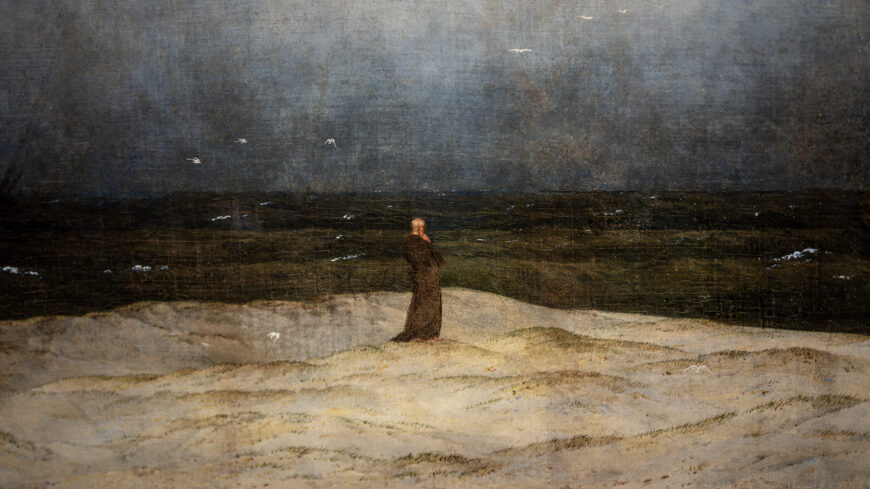
Caspar David Friedrich, monk (detail) Monk by the Sea, 1808–10, oil on canvas, 110 x 171.5 cm (Alte Nationalgalerie, Staatliche Museen zu Berlin)
There is some debate as to who that strange figure, curved like a question mark, actually is. Some think it Friedrich himself, others the poet and theological Gotthard Ludwig Kosegarten who served as a pastor on Rügen and was known to give sermons on the shore. Kosegarten’s writings certainly influenced the painting. Von Kleist, for example, refers to its “Kosegarten effect”. According to this pastor-poet nature, like the Bible, is a book through which God reveals Himself.
Similarly, stripping it of any literal Christian symbolism, Friedrich instead concentrates on the power of the natural climate and so charges the landscape with a divine authority, one which seems to all but subsume the figure of the monk. With nothing but land, sea and sky to measure him by, his physical presence is rendered fragile and hauntingly ambiguous.
The rückenfigur

Caspar David Friedrich, Wanderer above the Sea of Fog, 1818, oil on canvas, 37.3 × 29.4″ / 98.4 cm × 74.8 cm (Kunsthalle Hamburg, Hamburg, Germany)
Originally the figure was looking to the right. His feet still point in that direction. Friedrich altered this at some point, having him look out to sea. The technique of positioning a figure with their back towards the viewer is often found in Friedrich’s art; the German word for it is the rückenfigur.
Monk by the Sea, the first instance of it in his work, is somewhat atypical in that the monk being so small and situated so low on the horizon does not ‘oversee’ the landscape the way Friedrich’s ruckënfiguren generally do.
The technique is much more complex and intellectually challenging than those found in the picturesque. Acting as a visual cue, the figure draws us into the painting, prompting us, challenging us even, to follow its example and simply look. And so we do. Yet its presence also obscures our line of vision and rather than enhancing the view in the end disrupts it. In this sense, the ruckënfigur while reminding us of the infinite beauty of the world also points to our inability to experience it fully, a contradiction that we often find expressed in German Romantic art and literature.
A political statement
Napoleon’s army was occupying Prussia when the painting was completed and art historians have naturally looked to read the painting and its companion, which depicts of a funeral procession in a ruined abbey, as a comment on the French occupation. It would have been dangerous to be openly critical of Napoleon’s forces so the paintings’ political messages are subtly coded.
Both paintings were purchased by the young Crown Prince, Frederick William, whose mother, Queen Louise, had died a few months earlier at the age of 34. An extremely popular figure, she had pleaded with Napoleon after his victory to treat the Prussian people fairly. Her death surely would have been fresh in people’s minds when they saw the paintings, a tragic loss which was very much associated with the country’s own defeat by the French.
The presence of death is certainly felt in The Monk by the Sea, though in the monk’s resolute figure we also find a source of spiritual strength, defiance even, standing, like that gothic abbey and those German oaks in its pendant, as much perhaps a symbol of the resolve of the nation against the foreign military rule, as of the individual faced with his mortality.
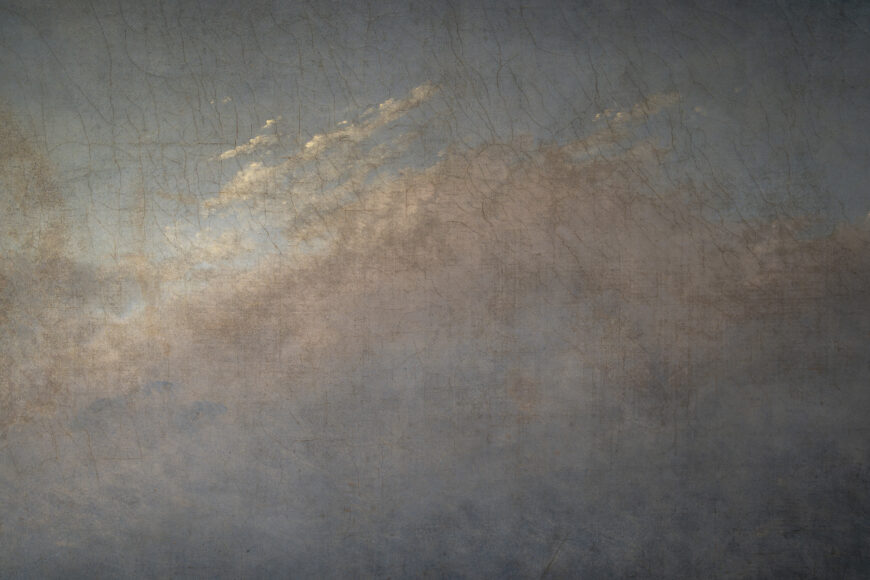
Caspar David Friedrich, clouds (detail) Monk by the Sea, 1808–10, oil on canvas, 110 x 171.5 cm (Alte Nationalgalerie, Staatliche Museen zu Berlin)
The Romantic
Like Constable, Friedrich drew on the natural world around him, often returning to the same area again and again. Unlike the English painter’s more scientific or naturalist approach, though, Friedrich condensed the image so as to communicate an exact emotion. As he put it, “a painter should paint not only what he sees before him, but also what he sees within himself.” It is this inward reaching project, using color and form to reveal emotional truths, that singles him out as one of the greatest and most innovative painters of his age: a true Romantic.


